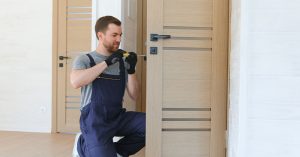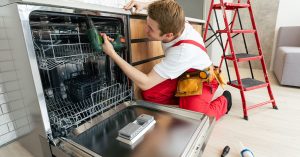Garage doors are one of the most used mechanical systems in many homes. That is to say, they are opened and closed multiple times a day, often without a second thought. However, when something goes wrong, it quickly becomes clear how important they really are. From minor noises to complete system failures, garage doors can develop a variety of issues that need attention.
Knowing the common problems and how they are fixed can help you understand when it is time to get professional help. Moreover, it gives you the confidence to identify early warning signs before they turn into larger concerns.
Door Won’t Open or Close All the Way
One of the most noticeable issues is a door that stops partway. Sometimes it opens halfway and then reverses. Other times, it may not respond at all. This problem is often related to the photo-eye sensors. These sensors sit near the ground on each side of the garage door and must be aligned to work properly.
If the sensors are blocked by dust, cobwebs, or even sunlight glare, they can prevent the door from closing. Therefore, one of the first steps a technician takes is to clean the lenses and ensure they are facing each other at the right angle. In other cases, the problem lies in misaligned tracks or bent metal parts that create resistance. To clarify, when tracks are damaged or bolts come loose, the door will struggle to move smoothly.
Technicians will typically check the track alignment, tighten loose bolts, and test the motor’s response. If needed, they may lubricate moving parts to reduce friction and improve operation. In some cases, they reset the travel limit on the opener so it knows exactly how far the door should go.
The Door Makes Loud or Unusual Noises
A noisy garage door might sound like grinding, squeaking, or popping. While many homeowners ignore this at first, the noise is usually a sign that something needs attention. Most importantly, it often means a lack of lubrication or wear in key parts like the rollers, springs, or hinges.
For example, metal rollers can wear down and rattle as they move inside the tracks. In the same vein, dry springs may groan when under tension. Technicians usually start by applying high-grade lubricant to the rollers, hinges, and springs. If the parts are too far gone, they may recommend replacing them altogether.
A professional might also check whether the bolts or brackets are loose. When parts vibrate during operation, they can create a clanging or banging sound. Re-securing these components is a simple but effective fix. In other cases, the motor gear may be worn out, especially if the opener is older. In that case, the repair will involve opening the motor casing and replacing the worn gear.
The Door Falls Quickly or Slams Shut
When a garage door closes too fast or slams shut, it creates a safety hazard. In other words, the door no longer has the tension needed to move slowly and safely. This usually points to a broken or worn torsion spring. Torsion springs are tightly wound and help counterbalance the heavy weight of the garage door.
If one breaks, the system loses balance and the door can drop uncontrollably. This is dangerous not only for people and pets but also for vehicles parked nearby. Repairing a torsion spring is not a DIY task. Because the spring is under extreme tension, technicians use specialized tools and procedures to safely remove and replace it.
They also check the remaining parts of the counterbalance system, including cables and drums. If any of these are frayed or misaligned, they will replace them during the same visit. As a result, the door regains smooth and controlled movement.
The Remote Control or Keypad Doesn’t Work
Another common issue is a non-responsive remote or keypad. Sometimes the door works fine using the wall button but ignores other inputs. Often this is caused by a dead battery in the remote or a misaligned signal. To clarify, remote controls use radio frequencies and need to sync with the opener’s receiver.
Technicians first test the remote and replace the battery if needed. If that does not solve the problem, they check the logic board inside the motor. This board receives the signal and sends the command to open or close the door. If the board is damaged or fried from a power surge, the only fix is to replace it.
Keypads on the wall outside the garage may also stop working. This could be due to worn buttons or a disconnected wire. Technicians will test voltage at the keypad, reprogram it if needed, or replace the unit entirely. For homes with smart garage systems, a faulty Wi-Fi connection can be to blame. In that case, they may reset the network settings or update the opener’s firmware.
The Door Moves Unevenly or Jerks
When a garage door wobbles or jerks on the way up or down, it often means the cables are worn or the rollers are uneven. For example, one side of the door may rise faster than the other, which puts extra stress on the system. Similarly, if a roller gets stuck or wobbles, the door can lurch unpredictably.
Technicians begin by examining the cables to ensure they are equally tight and properly seated in their drums. If one is fraying or stretched, they replace it. Next, they check each roller to make sure it spins smoothly and sits correctly in the track. If the roller bearings are damaged, the part is swapped out.
Additionally, they check the spring tension on each side. Uneven spring tension can cause one side to lift more easily than the other. By adjusting the springs evenly, the technician restores smooth and balanced movement. If ignored, these issues can lead to more serious damage to the opener or frame.
The Opener Motor Runs but the Door Doesn’t Move
Sometimes you might hear the opener motor running, but the door stays put. This often means the opener is disconnected from the door. Most openers have a manual release cord, usually red, that lets homeowners disengage the motor during power outages. However, if it was pulled and never reset, the opener will run without lifting the door.
Technicians check the opener arm and reconnect the trolley to the opener carriage. Once reattached, they test the door to ensure it moves properly. If the problem isn’t the release cord, the culprit may be a stripped gear inside the opener.
Older openers often rely on plastic gears that wear down over time. Consequently, they may spin without catching. A technician will open the unit and replace the internal gear kit, which restores function without needing a full replacement.
The Door Reverses Before Closing
If your garage door starts to close but then reverses suddenly, it may think something is blocking the path. Most doors are designed with safety sensors that trigger a reverse if an object is detected. However, this can also happen if the sensors are misaligned or the closing force is set too low.
The technician will first inspect the sensors to make sure they are clean and facing each other. If alignment is not the issue, they may test the door’s travel limits and force settings. These are typically programmed in the opener’s control panel and can be adjusted to match the weight and type of door.
Sometimes, older doors need slightly more force to close due to aging materials or heavy insulation. Technicians adjust the settings gradually, testing after each tweak, to make sure the door operates safely but firmly.
If you are seeing any of these issues and want to learn more about Garage Door Repair in Calgary, the process usually begins with an inspection. Most technicians arrive with the tools and hardware needed to complete common fixes on the spot.
You can get in touch with a qualified technician if you are experiencing any of the symptoms above. Ignoring early signs can lead to more expensive damage down the road, so it helps to act promptly when something seems off.
FAQ
What should I do if my garage door won’t open at all?
Check for power at the opener and try using the wall button. If nothing works, it may be a power issue or a broken spring. A technician can quickly diagnose the cause.
Is it safe to replace garage door springs myself?
No. Springs are under high tension and can cause injury if handled improperly. It is best to have a professional handle spring repairs safely.
Why does my garage door shake when it moves?
This is often caused by uneven cables, worn rollers, or track misalignment. A technician will examine all moving parts and replace or adjust them as needed.
Can cold weather affect my garage door performance?
Yes. Cold temperatures can stiffen lubricants and shrink metal parts slightly. That is why regular maintenance is especially important before winter.
How often should I get my garage door serviced?
Once a year is a good rule of thumb. Regular checks help prevent costly issues and ensure smooth operation all year round.



